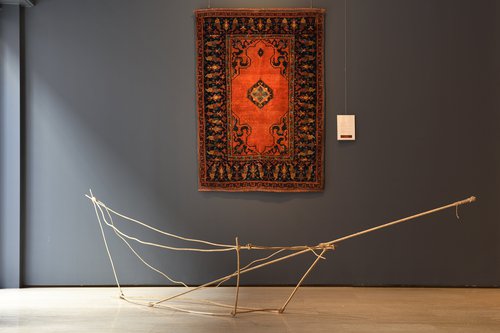Gallery Moshe Tabibnia is pleased to present from April 4th to May 25th, 2024 an unprecedented dialogue between Barca [Boat](1983-1985), a sculptural work by artist Hidetoshi Nagasawa, and the extraordinary collection displayed on the ground floor (Brera Room) of the gallery, which features five examples of 16th Century Small Medallion Ushak rugs, so-called "Tintoretto".
On the occasion of the exhibition Hidetoshi Nagasawa. 1969-2018 curated by Giorgio Verzotti, hosted from April 4th to July 20th, 2024 at the contemporary art gallery BUILDING in Milan, Gallery Moshe Tabibnia displays the artwork Barca [Boat] (1983-1985), consisting of a thin brass tube covered with Japanese paper that, in accordance with the place that welcomes it from time to time, explores new spatial dimensions, climbing walls, ceilings, or lying on the ground, following the evolution of the conception of sculpture and the transformation of the sense of matter.
“I would like things to always be very light, if you can't see them, it's almost better, they don't have to weigh down on the place [...]” *
The outline of the boat, with a thin white line, reveals an immaterial and open structure, which lightly navigates in space. Thus, the boat becomes a metaphor for experienced and dreamed, mythical and spiritual, journey; just as in the textile world, for ancient cultures and in the collective imagination, the carpet becomes par excellance a vehicle capable of transporting into a sacred atmosphere that expresses elevation, purity, and uniqueness.
Barca [Boat](1983-1985) finds its natural place in the exhibition spaces of Gallery Moshe Tabibnia, dedicated to "Tintoretto" rugs, which laid on the ground to accommodate the worshipper in prayer, act as a figurative link between the sensible and supersensible worlds.
The group of extremely rare Anatolian textile artifacts, dating from the 16th Century, entered common language under the name of the Venetian Renaissance master Jacopo Robusti, known as “Tintoretto”, who depicted them in two important paintings: “Susanna and the Elders (1550, Musée du Louvre, Paris) and “The discovery of the body of Saint Mark” (1562-1566, Pinacoteca di Brera, Milan). The exhibited rugs, on this occasion in a dialogue with Nagasawa’s artwork, while maintaining a similar compositional layout, bear elements of great originality in the refined design of the borders and spandrels. In addition to the two main types of borders that characterize these rugs, the “cloud-band” border and the “palmette” border, which are well illustrated by the items on display, there is a third type of border with a rich and elaborate floral decoration.
Another noteworthy element is undoubtedly the precious ornaments of the spandrels, which display the elegant Chinese-derived “cloud-band” motif and sinuous profiles of arabesque shapes, light and refined, sometimes enriched by the polychrome background.
The stylistic details seal the high artistic value of these rugs, which stand out for the preciousness of the ornamental peculiarities and the range of colours, identifying them among the most coveted and sought-after types in the production of the Ushak area.
The dialogue presented by Gallery Moshe Tabibnia between the "Tintoretto" rugs and Hidetoshi Nagasawa's Barca [Boat] (1983-1985) thus is part of the larger exhibition project of BUILDING, Hidetoshi Nagasawa. 1969-2018, a major retrospective that retraces the entire span of the artist's production, from his beginnings to his latest unseen works. An additional external venue of the exhibition: Casa degli Artisti that presents, from May 8th to June 4th, 2024, a collection of Nagasawa's artworks intended to restore the more project dimension of artist's daily work.
* F. Pasini, Hidetoshi Nagasawa, Massimo Kaufmann, (interview), Arca. Dieci capitoli di realtà, exhibition catalogue, Castello di Volpaia, Volpaia (Radda in Chianti), The books of Commenda, n. 8, Volpaia, Fattoria Editrice Castello di Volpaia, September 9th-24th, 1989, pp. 109-115.





